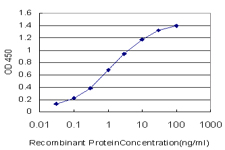HTR5A Antibody (monoclonal) (M01)
Mouse monoclonal antibody raised against a partial recombinant HTR5A.
- SPECIFICATION
- CITATIONS
- PROTOCOLS
- BACKGROUND

Application
| WB, E |
|---|---|
| Primary Accession | P47898 |
| Other Accession | NM_024012 |
| Reactivity | Human |
| Host | mouse |
| Clonality | Monoclonal |
| Isotype | IgG1 Kappa |
| Clone Names | 10D3 |
| Calculated MW | 40255 Da |
| Gene ID | 3361 |
|---|---|
| Other Names | 5-hydroxytryptamine receptor 5A, 5-HT-5, 5-HT-5A, 5-HT5A, Serotonin receptor 5A, HTR5A |
| Target/Specificity | HTR5A (NP_076917, 223 a.a. ~ 282 a.a) partial recombinant protein with GST tag. MW of the GST tag alone is 26 KDa. |
| Dilution | WB~~1:500~1000 E~~N/A |
| Format | Clear, colorless solution in phosphate buffered saline, pH 7.2 . |
| Storage | Store at -20°C or lower. Aliquot to avoid repeated freezing and thawing. |
| Precautions | HTR5A Antibody (monoclonal) (M01) is for research use only and not for use in diagnostic or therapeutic procedures. |

Thousands of laboratories across the world have published research that depended on the performance of antibodies from Abcepta to advance their research. Check out links to articles that cite our products in major peer-reviewed journals, organized by research category.
info@abcepta.com, and receive a free "I Love Antibodies" mug.
Provided below are standard protocols that you may find useful for product applications.
Background
The neurotransmitter serotonin (5-hydroxytryptamine, 5-HT) has been implicated in a wide range of psychiatric conditions and also has vasoconstrictive and vasodilatory effects. The gene described in this record is a member of 5-hydroxytryptamine (serotonin) receptor family and encodes a multi-pass membrane protein that functions as a receptor for 5-hydroxytryptamine and couples to G-proteins. This protein has been shown to function in part through the regulation of intracellular Ca2+ mobilization.
References
Association study of 182 candidate genes in anorexia nervosa. Pinheiro AP, et al. Am J Med Genet B Neuropsychiatr Genet, 2010 Jul. PMID 20468064.Serotonin (5-HT) receptor 5A sequence variants affect human plasma triglyceride levels. Zhang Y, et al. Physiol Genomics, 2010 Jul 7. PMID 20388841.Association study of the serotoninergic system in migraine in the Spanish population. Corominas R, et al. Am J Med Genet B Neuropsychiatr Genet, 2010 Jan 5. PMID 19455600.Differences and similarities in the serotonergic diathesis for suicide attempts and mood disorders: a 22-year longitudinal gene-environment study. Brezo J, et al. Mol Psychiatry, 2010 Aug. PMID 19381154.Case-control association study of 65 candidate genes revealed a possible association of a SNP of HTR5A to be a factor susceptible to bipolar disease in Bulgarian population. Yosifova A, et al. J Affect Disord, 2009 Sep. PMID 19328558.
If you have used an Abcepta product and would like to share how it has performed, please click on the "Submit Review" button and provide the requested information. Our staff will examine and post your review and contact you if needed.
If you have any additional inquiries please email technical services at tech@abcepta.com.













 Foundational characteristics of cancer include proliferation, angiogenesis, migration, evasion of apoptosis, and cellular immortality. Find key markers for these cellular processes and antibodies to detect them.
Foundational characteristics of cancer include proliferation, angiogenesis, migration, evasion of apoptosis, and cellular immortality. Find key markers for these cellular processes and antibodies to detect them. The SUMOplot™ Analysis Program predicts and scores sumoylation sites in your protein. SUMOylation is a post-translational modification involved in various cellular processes, such as nuclear-cytosolic transport, transcriptional regulation, apoptosis, protein stability, response to stress, and progression through the cell cycle.
The SUMOplot™ Analysis Program predicts and scores sumoylation sites in your protein. SUMOylation is a post-translational modification involved in various cellular processes, such as nuclear-cytosolic transport, transcriptional regulation, apoptosis, protein stability, response to stress, and progression through the cell cycle. The Autophagy Receptor Motif Plotter predicts and scores autophagy receptor binding sites in your protein. Identifying proteins connected to this pathway is critical to understanding the role of autophagy in physiological as well as pathological processes such as development, differentiation, neurodegenerative diseases, stress, infection, and cancer.
The Autophagy Receptor Motif Plotter predicts and scores autophagy receptor binding sites in your protein. Identifying proteins connected to this pathway is critical to understanding the role of autophagy in physiological as well as pathological processes such as development, differentiation, neurodegenerative diseases, stress, infection, and cancer.



